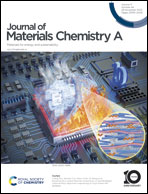Understanding the complex electronic structure of Mg3Sb2 and the effect of alloying through first-principles tight-binding models†
Abstract
Understanding the electronic origin of good thermoelectric (TE) transport properties is a crucial step to design and discover new TE materials. Mg3Sb2 is an intensely researched thermoelectric material, the high TE performance of which comes from six-fold degenerate conduction band minimum at low symmetry k points, leading simultaneously to a high Seebeck coefficient and a good carrier mobility. Furthermore, upon alloying, its low-lying conduction band structure changes, which improves or deteriorates the TE transport properties. Although extensively studied experimentally, the electronic origin of these changes is not well understood. Based on the first-principles derived Wannier function tight-binding analysis of both pristine Mg3Sb2 and its Bi/Ca alloyed derivatives, we reveal that the simple Mg s–Sb p orbital interactions are not adequate and sufficient to describe the electronic structure of Mg3Sb2. Inclusion of both higher energy Mg p orbitals and lower energy Sb s orbitals is demonstrated to be important to understand the shape of the lowest conduction band and its change upon alloying. The systematic chemical understanding developed in this work could enable us to better control the conduction band dispersion by manipulating chemical interactions in Mg3Sb2.



 Please wait while we load your content...
Please wait while we load your content...